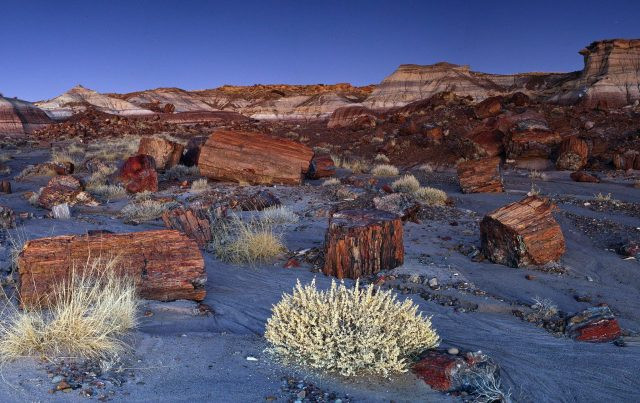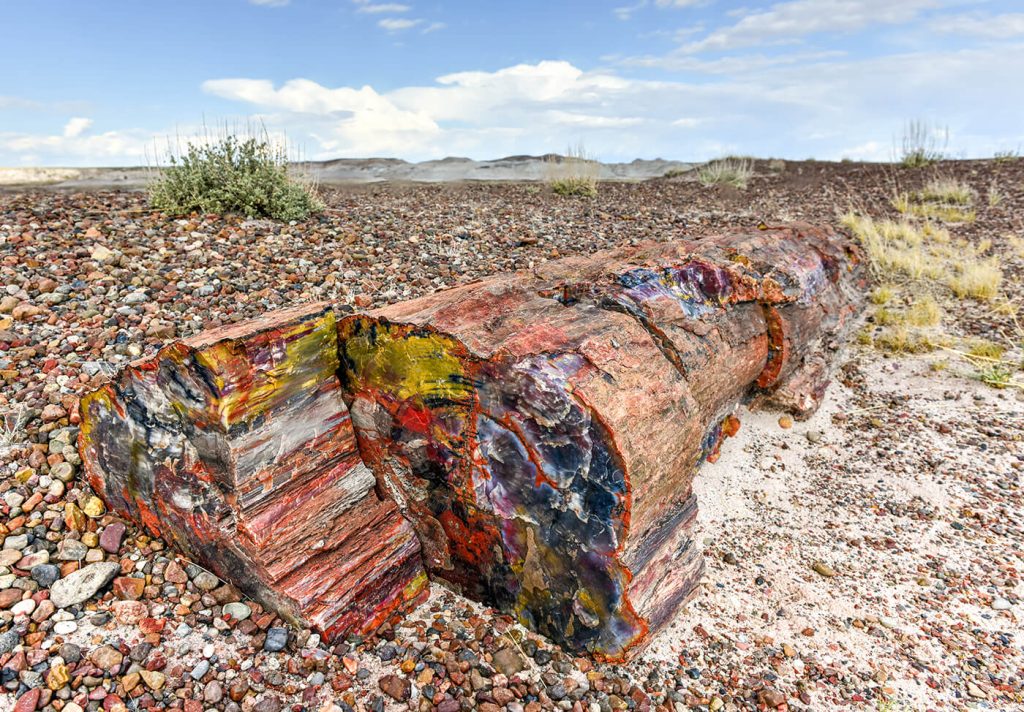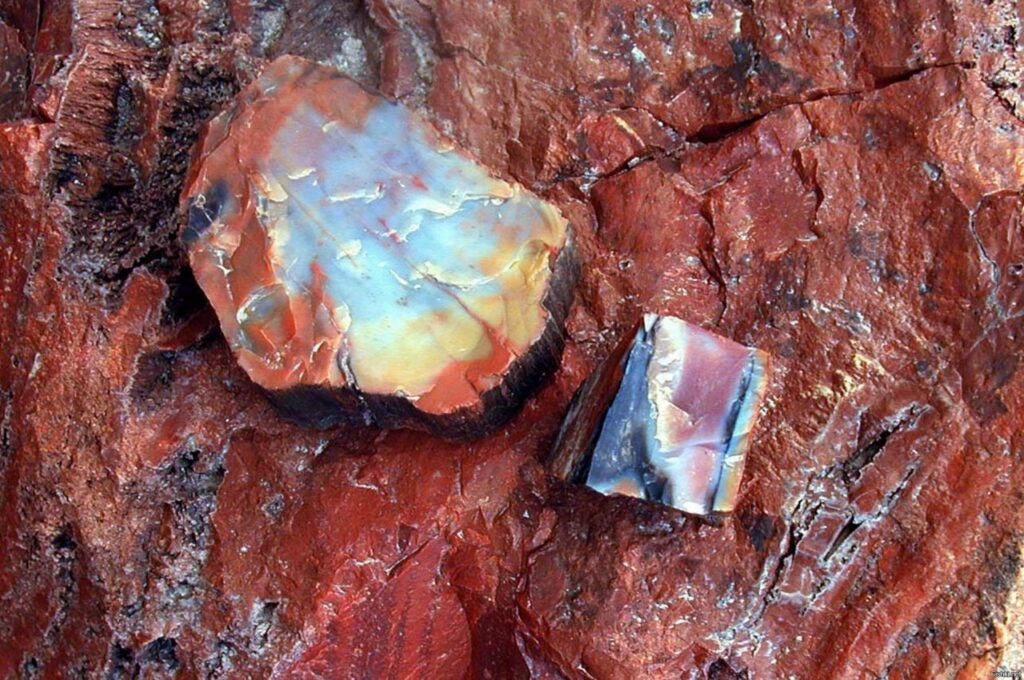In the arid expanse of northeastern Arizona lies a forest unlike any other—a mystical place where ancient trees have turned to stone, preserving their legacy for over 225 million years. This extraordinary destination, the Petrified Forest National Park, is a treasure trove of geological and historical wonders. Its vivid, gemstone-like remnants of prehistoric wood tell a story of transformation, resilience, and the forces that have shaped our planet through the ages.
Imagine a world during the late Triassic period, a time when the earth’s climate was vastly different. Lush, tropical forests dominated the landscape, teeming with life and vibrant vegetation. Towering conifers stretched skyward, some reaching an astounding 200 feet in height, with trunks as wide as nine feet. These majestic giants ruled the forest until their inevitable collapse. When they fell, they began a journey through time—a journey that would turn them from living organisms into timeless treasures.

The process of preservation began with nature’s fury. Powerful storms and volcanic eruptions swept across the land, burying the fallen trees under layers of sediment and volcanic ash. This rapid entombment was crucial in protecting the wood from decay. Encased within the earth’s embrace, the trees remained undisturbed as mineral-rich groundwater seeped through the layers. Over millions of years, a transformation took place. Silica and other minerals infiltrated the wood’s cellular structure, replacing organic material with stone. This phenomenon, known as permineralization, gave birth to petrified wood—a stunning fusion of the organic and inorganic, preserving the trees’ intricate details in crystalline form.
What makes the petrified wood of this park so remarkable is its vibrant array of colors. As the minerals replaced the wood, elements like iron, manganese, and other trace substances infused the stone with dazzling hues. Deep reds and rich oranges emerge from iron, while manganese produces shades of blue and purple. Together, these colors create a natural masterpiece, with each log and fragment displaying its own unique patterns. Visitors strolling through the park are treated to what can only be described as a geological art gallery, where every piece of petrified wood tells a story of Earth’s ancient past.
Over time, the elements began to reveal these buried treasures. Erosion, driven by wind and water, gradually stripped away the softer layers of sediment that had concealed the petrified wood for millennia. As these sediments washed away, the harder, mineralized wood remained, standing as resilient monuments to the passage of time. The landscape transformed into a surreal stone forest, where the remnants of prehistoric trees stand defiantly against the backdrop of the Arizona desert.
Yet, the Petrified Forest National Park offers more than just its iconic petrified wood. This 146-square-mile expanse is a window into a prehistoric world, home to a wealth of fossils that provide invaluable insights into life during the late Triassic period. Within its boundaries, scientists have uncovered the remains of ancient creatures that once roamed this primeval ecosystem. Fossils of giant amphibians, crocodile-like reptiles, and even some of the earliest dinosaurs have been unearthed here. These discoveries paint a vivid picture of an ancient world teeming with diverse and fascinating life forms.
The park’s fossilized flora and fauna tell a story of a dynamic and evolving planet. The ancient trees, with their petrified remains, provide clues about the climate and conditions that existed millions of years ago. Meanwhile, the fossilized bones of prehistoric animals offer glimpses into the interactions and adaptations of species long extinct. Together, these remnants create a comprehensive tapestry of life on Earth, helping scientists understand the processes that have shaped our planet over eons.
Despite its natural beauty and scientific significance, the Petrified Forest faces ongoing challenges. The park’s mesmerizing petrified wood has long been a target for collectors and souvenir hunters. Even with strict protective measures in place, an estimated 12 tons of petrified wood are illegally removed from the park each year. This alarming figure underscores the importance of conservation efforts to preserve this irreplaceable resource. Rangers and volunteers work tirelessly to safeguard the park’s treasures, ensuring that future generations can continue to marvel at its wonders.

The theft of petrified wood is not just a loss for the park but a loss for humanity’s shared heritage. Each piece of petrified wood is a time capsule, a tangible connection to a distant past. When taken from its natural context, the wood loses much of its scientific and educational value. By protecting these resources, we honor the stories they tell and the lessons they offer about our planet’s history.
For visitors, the Petrified Forest National Park is more than a destination; it’s an invitation to journey through time. Walking among the petrified logs, one cannot help but feel a sense of awe at the forces that have shaped our world. The intricate patterns and vibrant colors of the wood serve as reminders of nature’s ability to create beauty even in the face of destruction. The park’s expansive vistas, dotted with ancient relics, inspire reflection on the passage of time and the interconnectedness of life on Earth.
Beyond its geological marvels, the park offers a range of activities for visitors to enjoy. Hiking trails wind through its unique landscapes, providing opportunities to explore its rich history and natural beauty up close. The Blue Mesa Trail, for example, takes visitors through a striking badlands area, where layers of colorful sediment create a stunning backdrop for the petrified wood. The Giant Logs Trail showcases some of the largest and most impressive specimens, including “Old Faithful,” a massive petrified log that stands as a testament to the park’s ancient history.

The park also features a visitor center and museum, where guests can learn more about the science behind petrified wood and the region’s paleontological discoveries. Educational programs and guided tours offer deeper insights into the park’s significance, making it a destination that appeals to both casual travelers and avid enthusiasts of natural history. For those seeking a more immersive experience, the park’s wilderness areas provide opportunities for solitude and reflection, away from the bustle of modern life.
The Petrified Forest National Park is a living testament to the power of time and the forces that shape our world. Its petrified wood, with its vibrant colors and intricate patterns, stands as a symbol of transformation and resilience. The fossils within the park tell stories of a world long gone, offering glimpses into the lives of creatures that roamed the Earth millions of years ago. Together, these elements create a landscape that is both breathtakingly beautiful and scientifically invaluable.

As we walk among the stone sentinels of the Petrified Forest, we are reminded of our planet’s ever-changing face. The park invites us to connect with Earth’s history, to marvel at its beauty, and to reflect on our place within the grand story of life. By preserving this natural wonder, we ensure that its lessons and its legacy endure for generations to come. Whether you’re a scientist, a nature lover, or simply a curious traveler, the Petrified Forest National Park offers an experience that is as enlightening as it is inspiring—a journey through time that leaves an indelible mark on the heart and mind.





